Breaking the grass ceiling

For the first time since records began, American women are consuming more weed than men. Almost 25 years on from reefer bro films like Dude, Where’s My Car? and Pineapple Express, what does the stoner look like in 2025?
Life
Words: Tiffany Lai
Photography: Richard Kern
Taken from the spring ’25 issue of THE FACE. Get your copy here.
The first time I pretended to be stoned was also the first time I smoked weed. Propped up on a toilet cistern in a stall with two other 14-year-old girls at a community centre party in a tangential suburb of London, we’d ducked out of the blare of Miley Cyrus’s We Can’t Stop to seek respite in the girls’ bathroom. Inside, it was freezing, thanks to an unclosed window, and the taps were surrounded by little pools of spilled pink soap.
We’d come to the party, dropped off by our parents of course, because there was a promise of meeting boys (girls’ school makes you decidedly unchill about these things). But what proved much more interesting to me was Gem*, a friend-of-a-friend. She had been invited along by my classmate Eva*. (*Not their real names.) Gem embodied everything a 14-year-old girl aspires to: she was beautiful in a way that made her look older, had boobs when many of us still wore bras you had to put on over your head and, most importantly, she did that most transgressive of things: she smoked weed.
“If a girl smokes weed, it adds to her coolness. If a guy smokes weed, I might be a little disappointed in him”
Besarta Mulosmani
Shortly after Gem arrived, in a bandeau and low-slung trackies, she deemed the party “lame” and the boys “weird”, quickly ferrying Eva and I into the innermost stall of the bathroom. Outside, bouncers (older brothers in high-vis vests) scanned the terrace, keeping an eye out for dodgy water bottles carrying cocktails of squash and Glen’s Vodka. Holding it between her long nails, Gem lit up a small joint. It was rolled loosely, and caught quickly on one side – soon, the stall began to fill with thick, musty smoke. Taking a few quick drags each, we pushed each other out of the stall as the smoke began to curl threateningly under the door, towards the mirrors and on to the world outside.
Later, we laughed as we watched the bouncers run around the terrace, looking for the source of the hotbox. Unaware of how to inhale properly and high on little more than adrenaline, I acted stoned, giggling and talking slowly, hoping that those around me would catch on without me baiting myself out to the authorities.
I couldn’t have verbalised this then but I certainly sensed it: in the words of Besarta Mulosmani, one of the models photographed in this feature, “if a girl smokes weed, it adds to her coolness. If a guy smokes weed, I might be a little disappointed in him.”
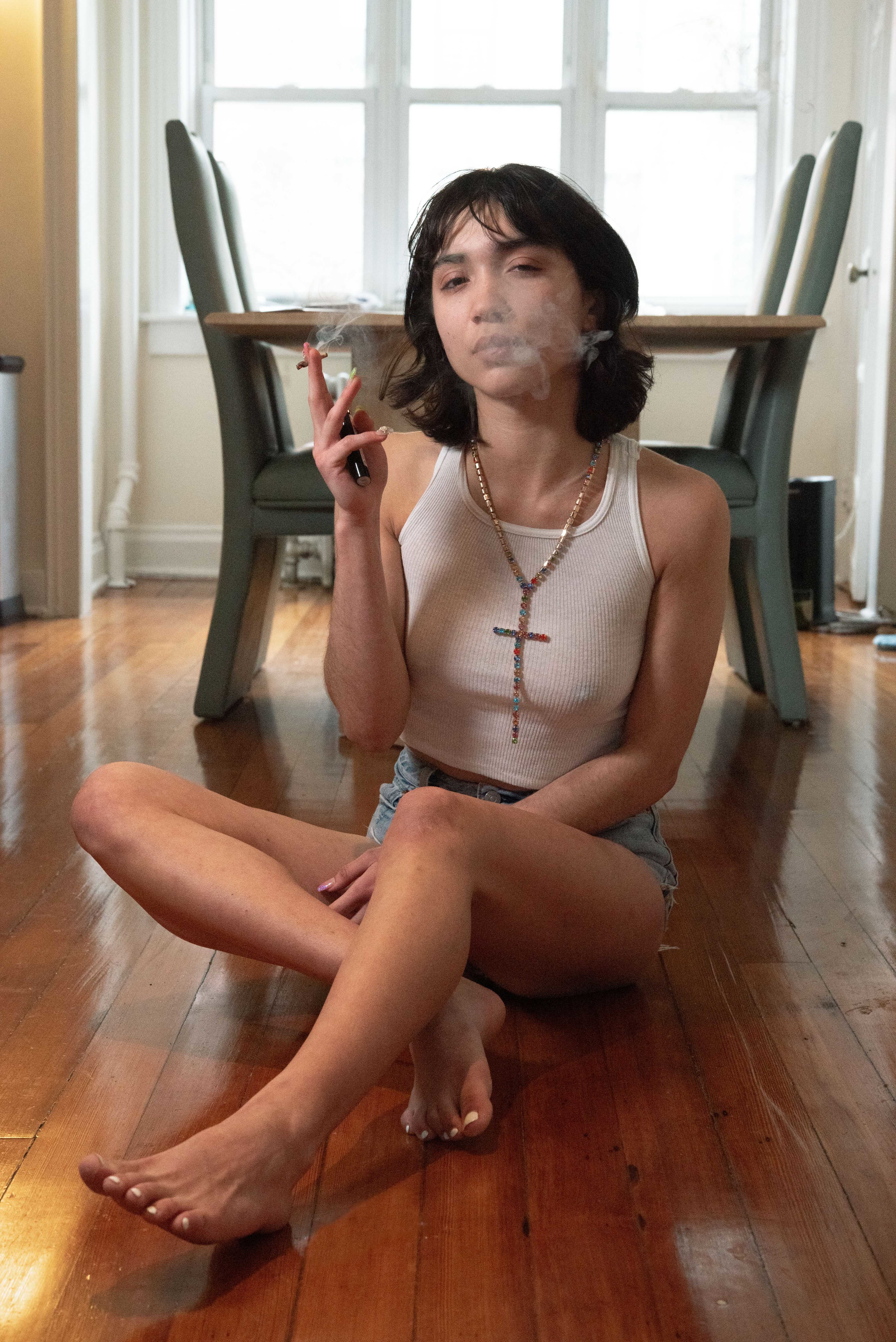
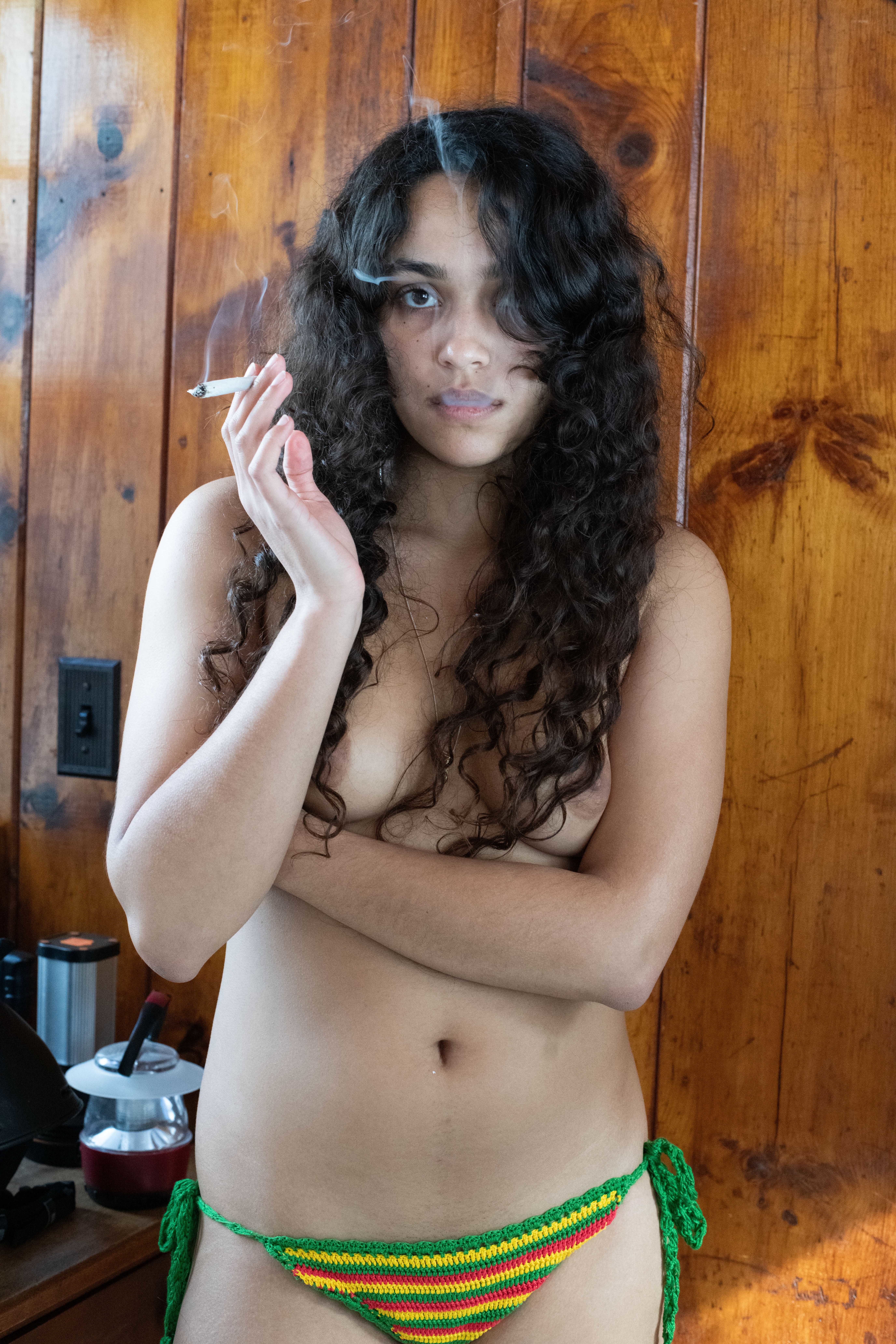

In 2024, a decade on from my first crumbly joint, the University of Michigan published the latest edition of its ongoing research project, Monitoring the Future. Examining young people’s drug use by drawing on data collected since 1975, it revealed that for the first time since records began, American women between the ages of 19 and 30 were consuming more cannabis than men.
It’s a fact that may surprise you. Think of the teenage stoner and you probably think of the teenage boy. Think of the enthusiastic twentysomething smoker and you likely think of lads playing FIFA or ripping into a huge glass bong watching daft cartoons. It’s a gender/drug association that Hollywood has only amplified. The Harold & Kumar franchise, Knocked Up, Dave Chappelle’s classic Half Baked, Friday and Scary Movie have all played a part in associating men with weed in the popular imagination – along, of course, with the stereotype of the lazy pothead in a pizza-grease-stained top who refuses to grow up. But as the law has changed, so has the consumer.
The initial legalisation of recreational cannabis in Washington, Oregon and Colorado in the mid-2010s provided an opportunity for women to enter into a new industry, both as open users and business owners. Since those early breakthroughs, weed has been made legal for medical use in 39 states, with 24 of those allowing for recreational use. With the commercialisation of newly legal cannabis has come fresh commercial opportunities. Dispensaries, bong crafters, gummy manufacturers, pre-roll brands, CBD oil makers and more have sprung up, many of them helmed by and aimed at women – because, of course, this is capitalism, and they were an untapped, or at least underserved, market.
In a 2019 study by MJBizDaily, almost 37 per cent of executive-level positions in the business of cannabis were held by women in the US, compared to just 21 per cent across other industries nationwide. The image of a new weed smoker began to emerge: female, business-savvy and keen to bring a touch of luxury to smoking.

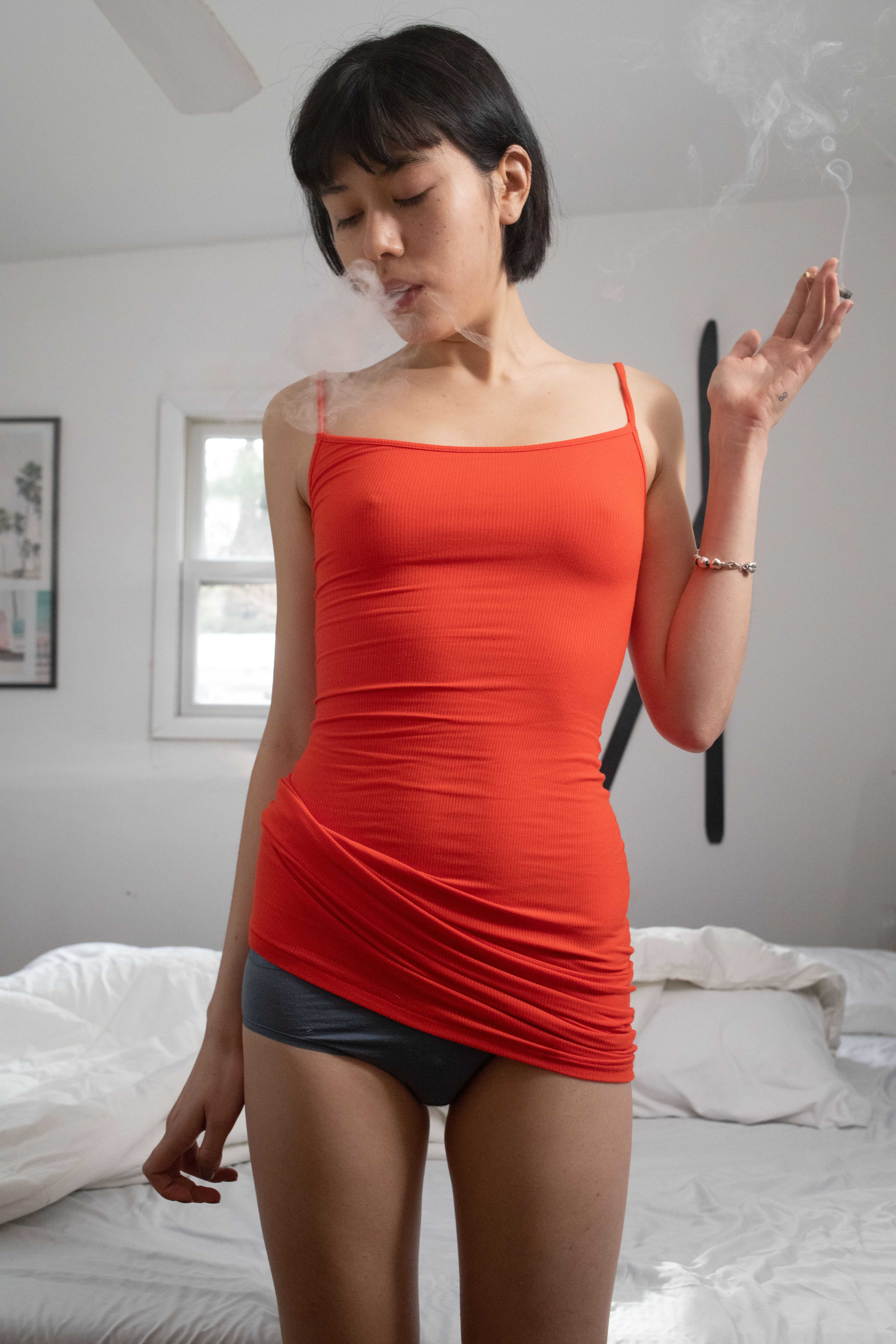
On Doreen Sullivan’s website she’s described as “not just an entrepreneur but an ultrapreneur”. As the founder of My Bud Vase, a luxury bong company marketed at women, the Las Vegas-based businesswoman has spent 10 years making discreet smoking vessels that resemble beautiful vases, complete with fake flowers whose stems double as pokers.
When she started the business in 2015, after vowing to do her final “hide the bong dance”, she began by catering partly to a consumer base that still wanted to hide their consumption. “There’s probably more stigma around mothers,” she says. “But I have two children and I feel like they’re the result of a healthy mother with cannabis. I always hid my consumption [from them] but it made me a better parent, because I could be present and transition from a hard day’s work.” During the pandemic, Doreen’s business grew tenfold because “everybody was staying at home and consuming. It was a coping mechanism that seemed to gain momentum.”
She says that, as the stigma lessened, partly due to a shift in legality and wider conversations about mental wellness and health, women began to be more open about their usage, whether it was as pain relief for PMS and endometriosis (a condition that affects one in 10 women in the UK) or to unwind after a long day at work or parenting.
“The woman stoner just simply lacks representation! Where’s Pineapple Express for the girls?”
Chloe Kekovic
Many of the women I spoke to for this story describe their cannabis usage as a form of self-care and an aid to creativity. Eloisa Santos credits weed with “sparking a different perspective”, while fellow model Alice McNally said that she smoked the most when living in Hawaii (where small amounts are legal for recreational use) at a time when she was “eminently focused” on her personal growth and wellbeing.
For Besarta, it’s a nice accompaniment to organising laundry or planning a photoshoot. “From my own experience, I notice that men use it more strictly for relaxation, while women tend to use it more alongside other activities,” she says. “My best friend will have a few puffs as she carves out her next DJ set. From what I’ve seen, men really lose their sharpness while high. I don’t think women tend to be affected as much in that way.” Though it’s an interesting observation, other interviewees are reluctant to draw distinctions down gender lines.
Riley Brain is the founder of ceramic bong business Wandering Bud, based in Kansas City, Missouri, where it’s legal for both recreational and medical use. She attributes a rise in women’s cannabis consumption to a decrease in alcohol consumption across the sexes. “I imagine the younger generation is smoking more weed and avoiding alcohol hangovers. Anecdotally,” she adds, “I was a little surprised to hear from Boomer-aged family friends that they were becoming weed-curious as a result of legalisation. I’d [often] hear some variation on this story: ‘Now weed is legal and I’m having back pain, I don’t want to take opioids and cannabis has really helped manage my pain.’”
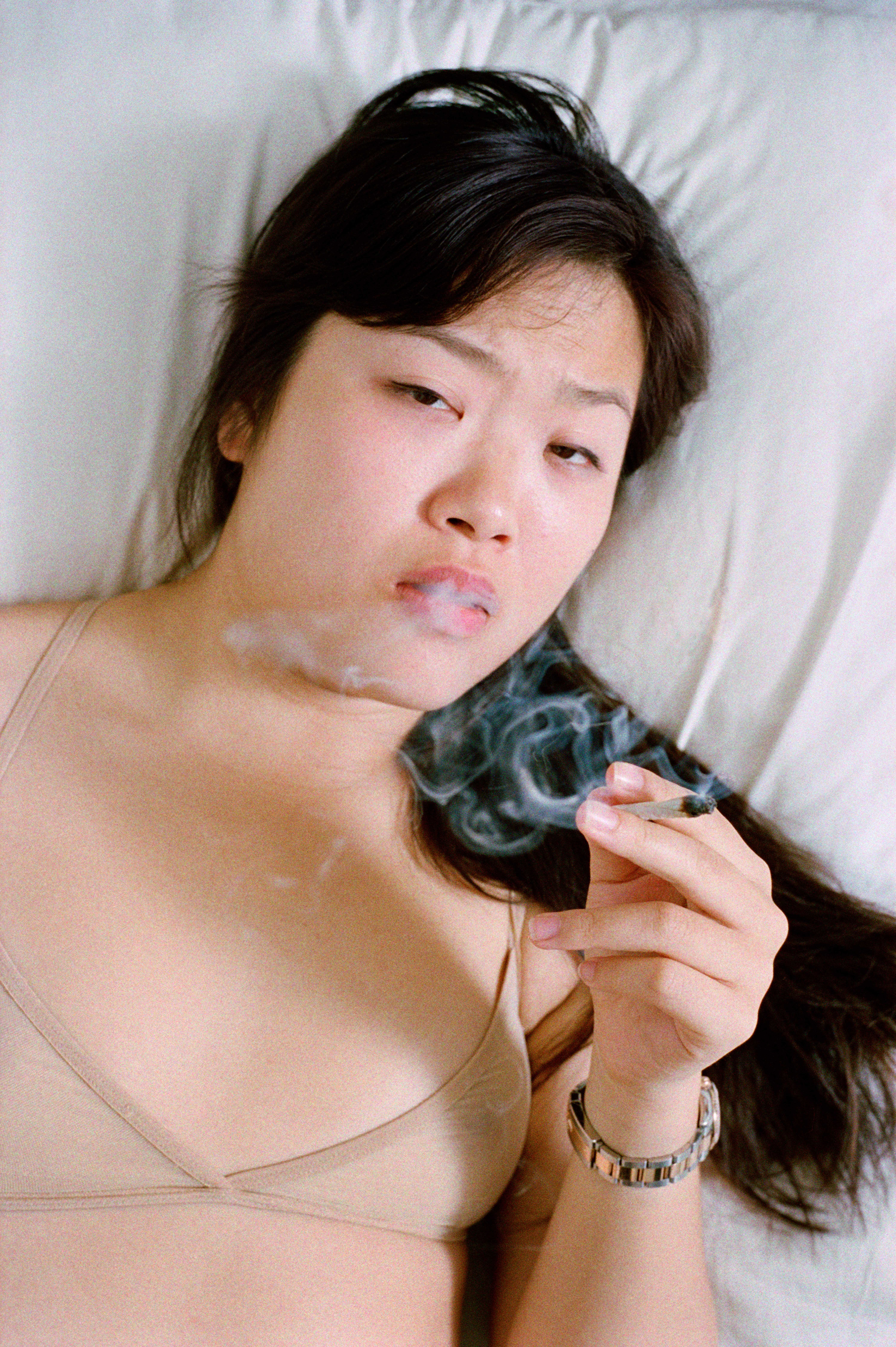
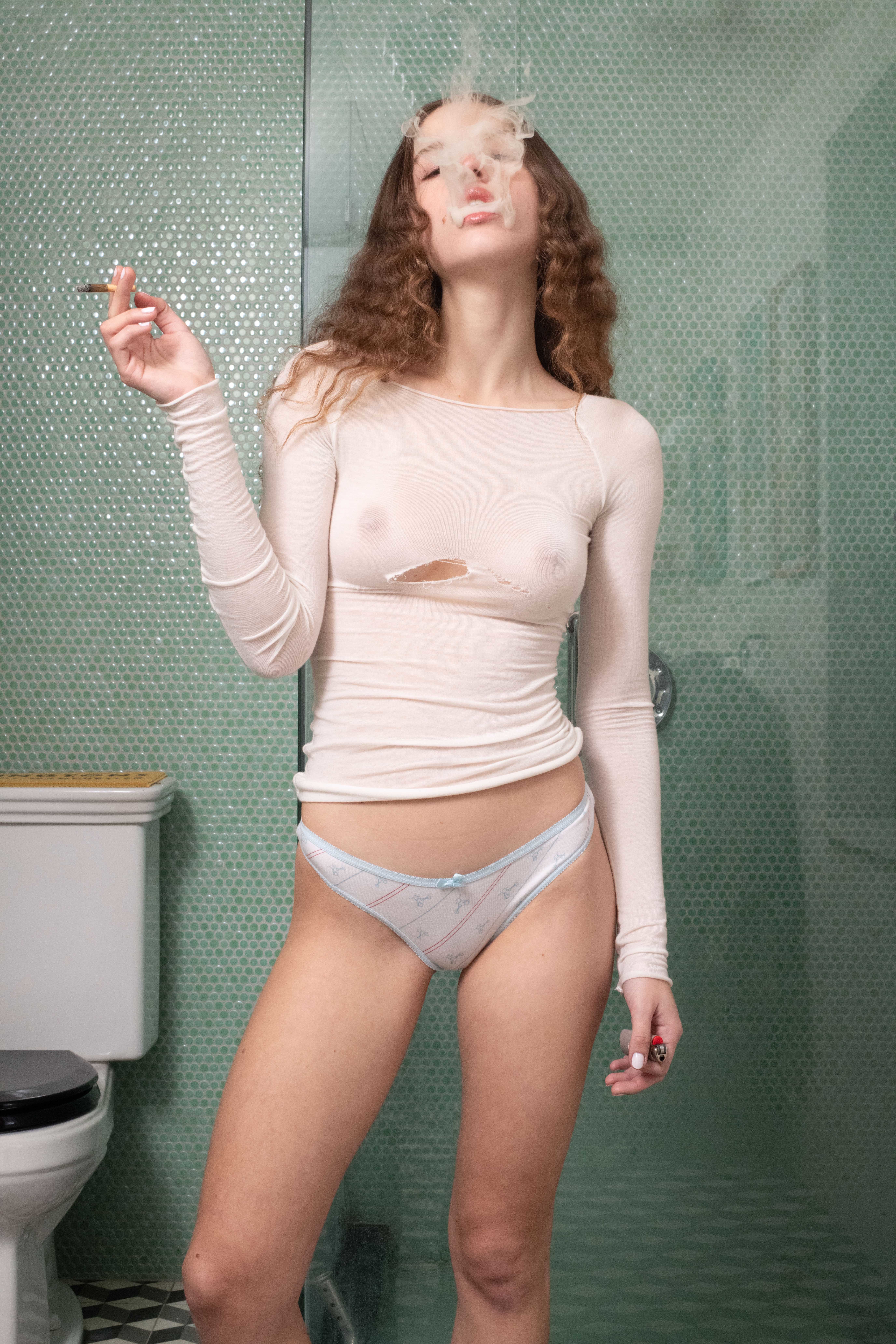
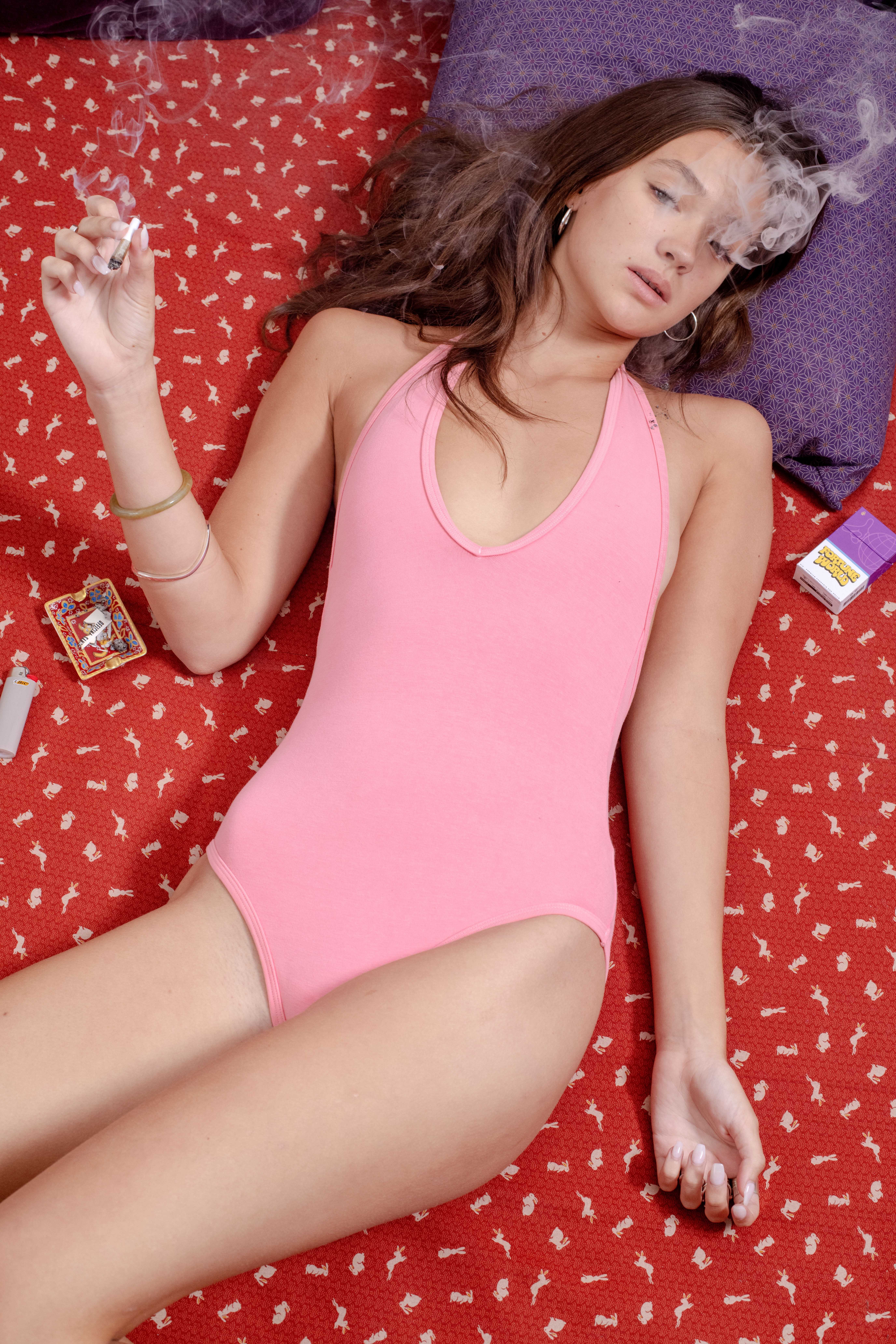
Still, it can’t be denied that more women consuming weed has complicated the stereotypical images of tokers. As model and artist Chloe Kekovic says: “The woman stoner just simply lacks representation! Where’s Pineapple Express for the girls?” The answer may lie in the form of Natalie Benson.
Scrolling through her TikTok, she has all the markings of the type of influencer who has become synonymous with Stanley drinking cups. With her hair pulled back in a claw clip, wearing a fleece and gold hoops, she speaks casually to camera from an aspirational, country-style kitchen. She refers affectionately to her viewers as “gardeners” and often mentions “doinkers”, her censor-evading term for joints and the name of her merch company, which sells mugs and oven gloves emblazoned with phrases like “Wakey Bakey” and “Freshly Baked”. The 28-year-old – who works with Hennep, a dispensary in Cape Cod, Massachusetts (where use (where use is legal) – started smoking during Covid. She was trying to cut down on alcohol and wanted a reset after being prescribed Vyvanse, a stimulant used for treating ADHD. She found that when she microdosed edibles, it helped with her focus. Now she smokes [checks notes] “all day, erry day”.
Her content, though, isn’t centred around clichéd stoner activities like gaming or snacking, or even showing off new buds or tools. Instead, her days look much like any other influencer’s: meetings, cooking and getting coffee (plus horse riding and making comedy skits with her husband). It’s not the average person’s life, sure, but it hardly differs from the content of someone like Emma Chamberlain. She just happens to be rolling a joint most of the time.
“I personally feel that the [stoner] stereotype is so outdated. In this day and age, so many people from different walks of life consume cannabis for different needs,” she says. “I remember in high school and college, people used to say that ‘girls who smoke weed are gross’. Frankly, if you still think that way, the door is that way.”
Her 450,000 TikTok followers (she has a further 300,000 on Insta) seem to agree, with one “fellow gardener” going on camera to praise her content, calling it “very relatable”. And Natalie’s appeal perhaps gets to the crux of how more women than men are now seemingly enjoying weed: contrary to what we might call “traditional” or stereotypical patterns of use, hers isn’t a life that revolves around cannabis. Rather, it’s the other way around, with weed just another lifestyle accessory, one that enhances rather than stupefies.
Smoking weed regularly doesn’t necessarily make them (or anyone, really) a zoned-out scrub on the sofa in the same way that a glass of wine with dinner doesn’t make you Ernest Hemingway. In fact, when I tell Natalie that women cannabis users have now overtaken men, she’s pleased but says that she had seen it coming. With a majority-women audience, she already knew what my 14-year-old self intuited: “Hot girls smoke weed, too!”
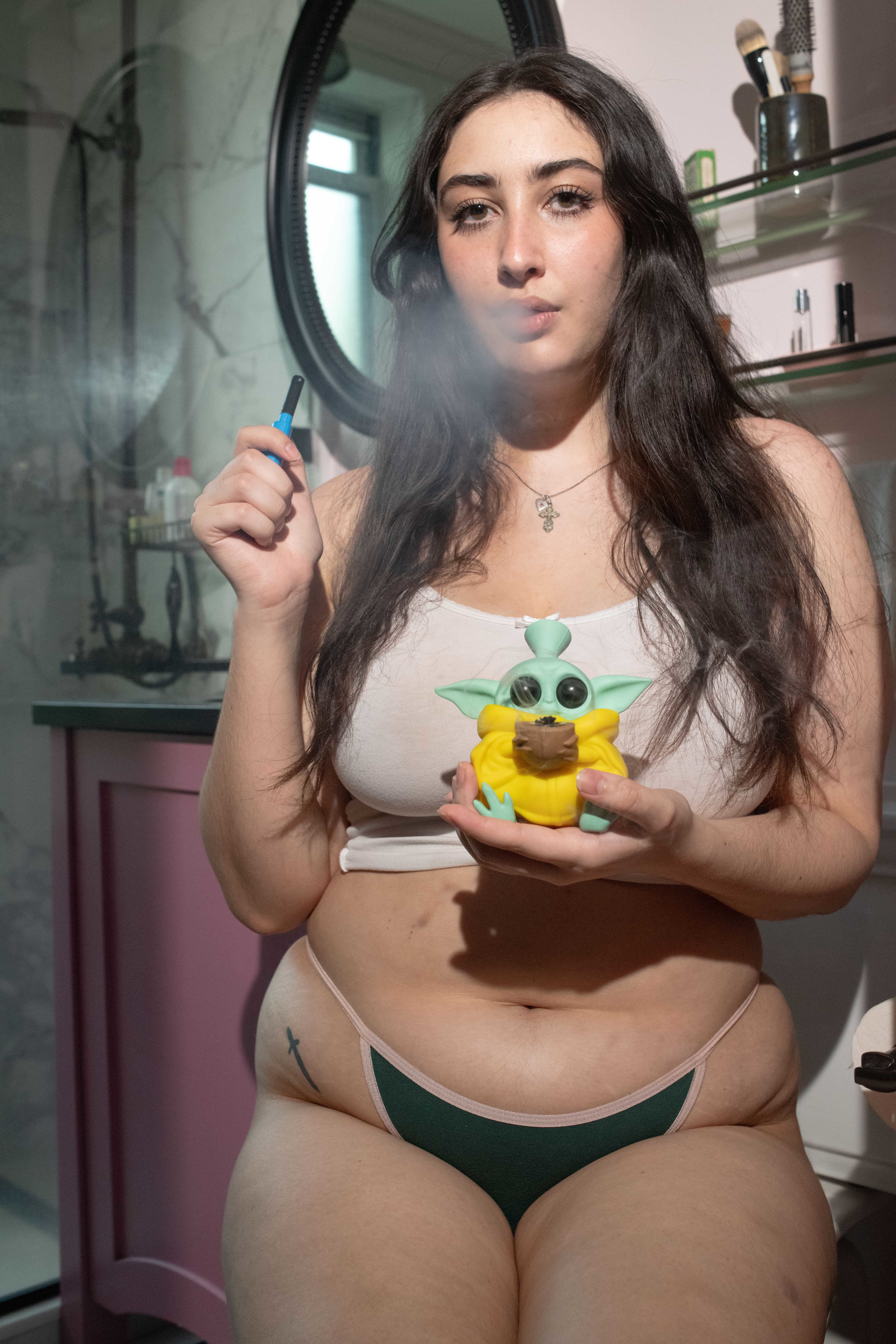
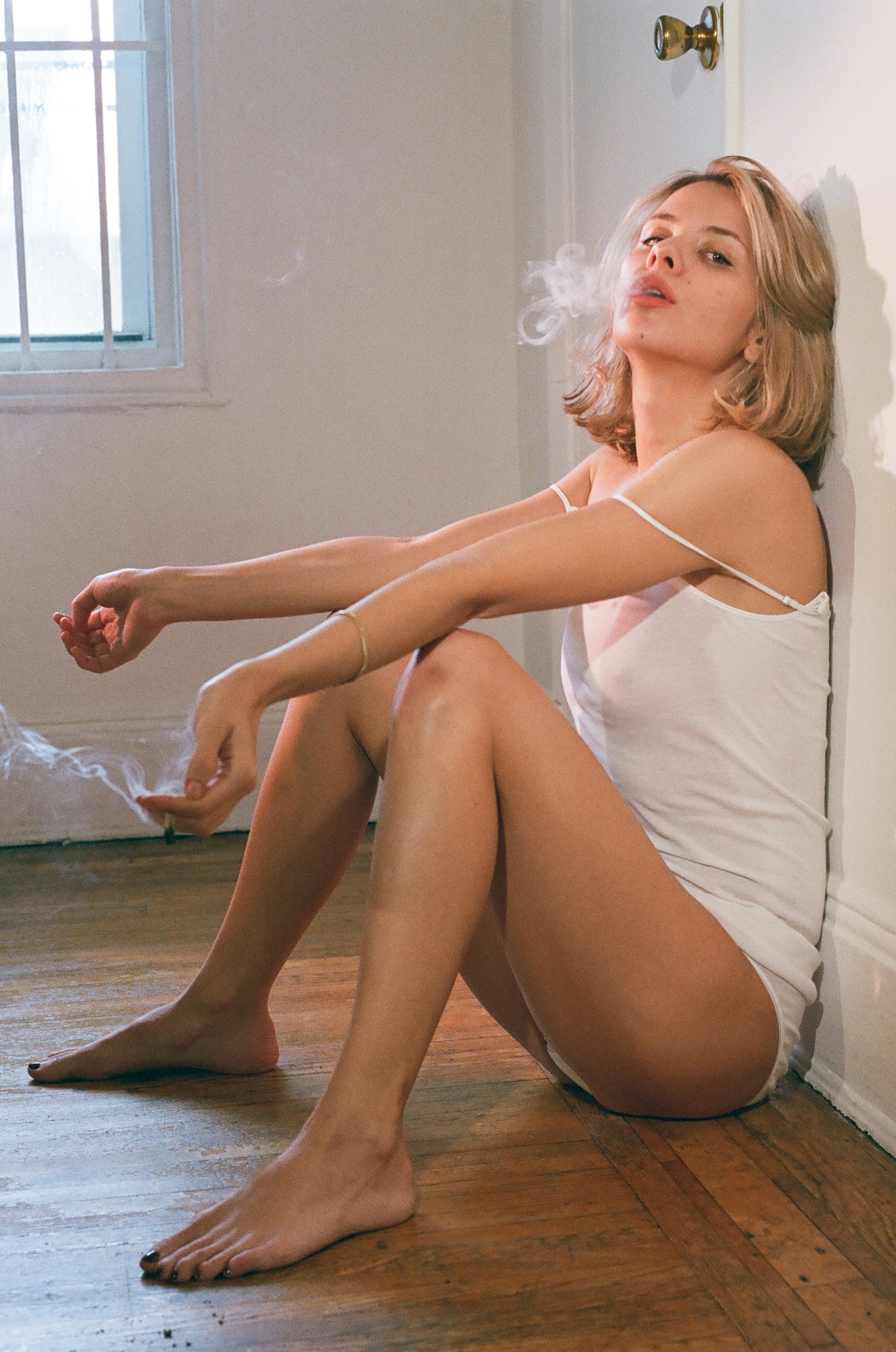
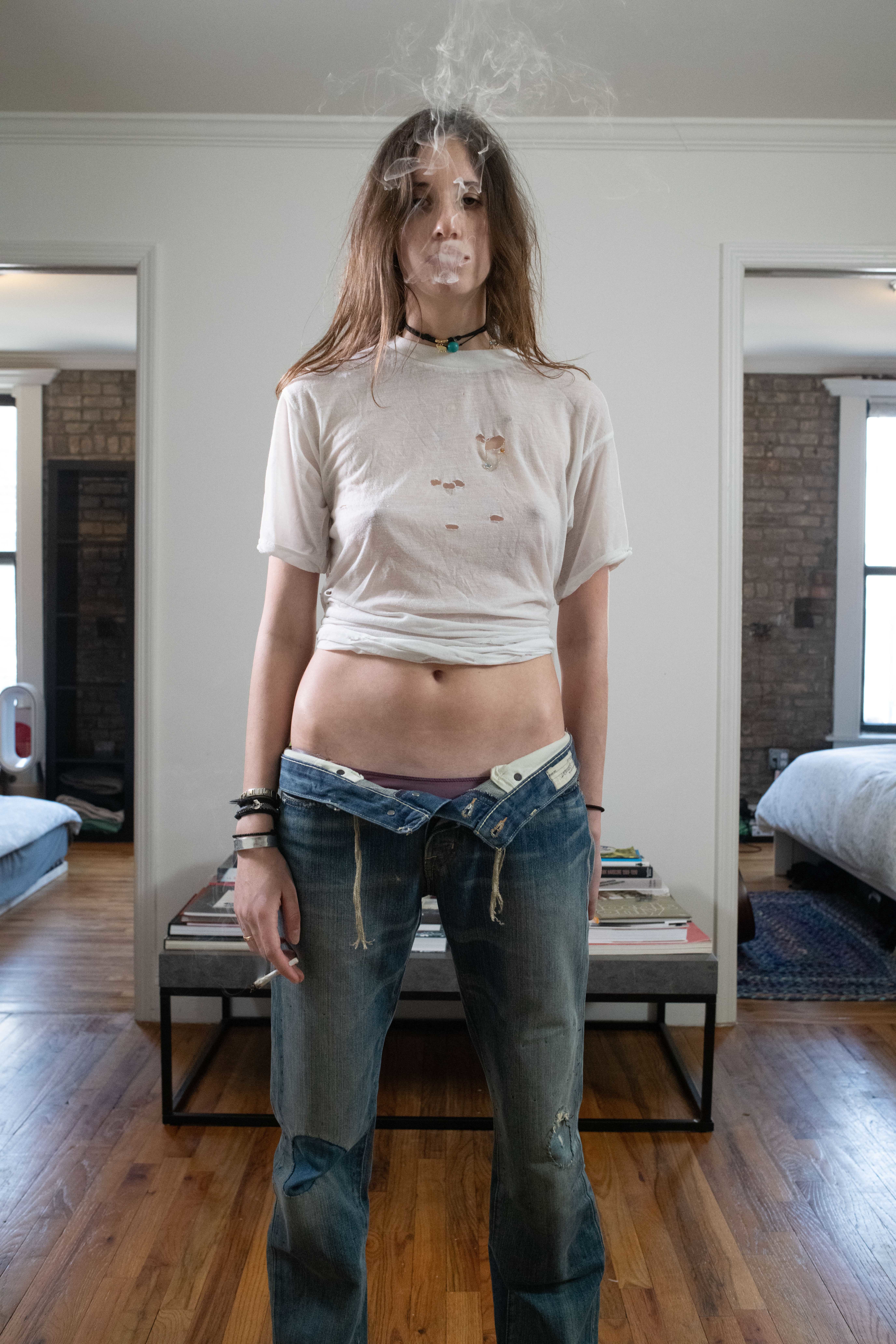
Besarta Mulosmani, 23 model and computer science student

Did you know that the number of women consuming weed has surpassed men?
Girls like to chill! Most men I know are more turned on by drinking, blow and nitrous oxide.
Do you think that men and women experience being high differently?
I suppose being high is more aligned with a woman’s natural state of being: open, intuitive, feeling. So I guess, to me, men smoking weed seems a little unnatural. But maybe that’s a good reason for them to do it, too. Once I smoked with a guy I’d been seeing and he wasn’t a smoker whatsoever. He was totally acting like a happy baby after three hits. It was actually really cute, since I’d only seen him be this big, strong, responsible version of himself.
When do you tend to smoke?
Ideally, at the end of a long day, after a long shower, in fresh sheets and with a good reality TV show or video game.
Can you describe how your high feels?
It feels peaceful. My body and mind feel less tense and knotted up. The noise of the world is shut off and I’m up in my princess tower. Smoking is when I get uninterrupted time with myself, when I get to disconnect from my stresses, and it’s a real comfort. It’s like working at a restaurant and going to hit your vape in the bathroom during rush hour. The noise and demands of the world persist, but for that moment you get to cherish total solitary relaxation. Very zen.
Rosa Polin, 29 photographer

Did you know that the number of women consuming weed has surpassed men?
I did not know. Is everyone OK?
Can you describe how your high feels?
It relaxes me into my body and quiets my thoughts, or the opposite.
Do you think that men and women experience being high differently?
I do, but anything I think is conjecture. My guess would be that women get high to stop feeling so much, men get high and start to feel so much they need to quit.
What’s the primary reason you smoke?
I’m a creature of habit.
Is it a social or solitary thing for you?
Extremely solitary.
Alice Mcnally, 20 fashion student/model

Did you know that the number of women consuming weed has surpassed men?
No. I’m happy I do now, though. For a long time, the idea of women smoking weed was seen somewhat as taboo, so [it] reflects a lot of development in the way society has progressed and changed. I think it’s really cool.
Do you think that the public perception of men smoking weed and women smoking weed is different?
Definitely. Although there’s been a huge improvement, I think there’s still a lingering old-school perception that it’s “unfeminine” or “irresponsible” for women to smoke weed.
Do you think men and women smoke for different reasons?
I think that, overall, it depends on the individual. However, from what I’ve seen, women tend to smoke weed in a more holistic manner and often incorporate it into wellness, finding a multitude of ways that it can be beneficial or constructive. Although it happens, I see that kind of useless in men and instead see it being a more social, less health-conscious activity.
Can you describe how your high feels?
There are a lot of things that contribute to how my highs feel and what I experience, but overall I am given a sense of release from the outer world and an inner peace that is often challenging to grasp when living in a metropolis.
Eloisa Santos, 26 actor/model

Did you know that the number of women consuming weed has surpassed men?
I’m not surprised – I know a ton of women who smoke. It feels like it’s just becoming more normal, and people are more open about it now.
Do you feel like people have ever treated you differently for smoking weed than they would have treated men?
I’ve had some snotty people in the past give me and my friends funny looks. But, honestly, those types usually don’t mind their business anyway.
What’s the primary reason you smoke?
I like to smoke to tap into my creativity or find focus. It can help with breaking through mental blocks or getting into a flow, especially when I need to think outside the box. It’s not just about unwinding, but more about sparking a different perspective.
What has weed brought you in your life?
Weed has brought me lots of good times. It’s helped me relax, connect with friends and see things in a different light.
Chloe Kekovic, 30 actor/filmmaker

Did you know that the number of women consuming weed has surpassed men?
It doesn’t surprise me, though I’m inclined to believe that this is just classically skewed data, as women didn’t always feel ready to freely and comfortably admit to engaging in the practice. We’re also tired. Like, women are tired. The world is heavy – with balance, intentional engagement and practices. We should all enjoy what we need to to find our own pockets of feeling good.
Do you feel like people have ever treated you differently for smoking weed than they would have treated men?
The only person who ever shamed me for weed smoking was a nasty guy I dated (fuck him). Growing up in NYC, weed was ubiquitous and readily accepted by those around me. Well, except my parents of course, but that’s its own thing.
What has weed brought you in your life?
Laughter, expansiveness, glee, sensuousness, sunshine, visions, prophetic downloads, yet also existentialism, fear, pain, cloudiness, blues. Drugs always meet you where you are, and to me serve as the greatest window into the subconscious. I adore them for that.
Photographs taken from Contact High (2013), Extra High (2020), Super High (2024), all by Richard Kern












